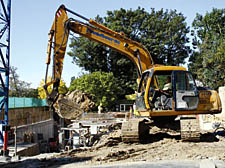|
|
 |
| |
Madness of double and triple basements
It’s time to put a stop to the digging, says Tony Hillier, who wants to see subterranean developments in Hampstead restricted to one floor underground
FEELINGS run high and mainly against big basements in Hampstead.
It’s a good way for those in favour to avoid stamp duty, when one’s family and income start expanding.
After all, it’s national policy to increase housing density.
The Heath & Hampstead Society, on the other hand, believes that across the fault lines of north London sand and clay, criss-crossed by the sources of four of London’s rivers, we have already endured too many collapsed or damaged homes neighbouring newly-dug basements, too much land instability in the local environment, and too big an increase to the ever-present risk of floods.
It is no longer tolerable that Camden should give planning permission to, for example, triple, that is, 30ft basements in this beautiful, but unstable, and hilly conservation area. It’s time to stop the digging.
Stopping this travesty is not that simple.
National planning guidelines clearly place on Camden the duty to guard against developments which increase local ground instability. Camden’s own adopted 2006 Plan was rather weak on this issue, and has since been further weakened under blanket government direction (not aimed at basements).
Camden’s new Local Development Framework, which is out for consultation, has some excellent draft policies, proposing to adopt a clear duty as the local planning authority to prevent ground instability or increased flood risk from basements.
The problem is that this will not have the full force of law until late 2010. With strong local support, however, these draft policies can still play a significant role.
This support is now crucial. The legal delay is being cynically exploited by developers with complex geotechnical reports; they claim that with modern construction methods there is no problem digging a 30ft hole and sticking in two dwelling floors and an air-conditioned swimming pool under, for example, a listed building between two other 19th century listed buildings, with weak foundations and single basements.
It is true that if the immediate neighbour has the wherewithal (and not many do) he or she can hire their own structural and geotechnical engineers and party wall solicitors, and Camden might listen. However, the wider impacts (each deep basement regrettably creates a precedent) are, at the individual case level unpredictable, but almost certainly, on a cumulative basis, dangerous.
This is where the will of the people should be heard to strengthen the hand of the planning authority. We say that the norm in Hampstead should be no more than single basements.
The scenario I have just described is not a fairy tale. There is a specific test case coming before the development control committee in the near future.
Having taken our own geotechnical advice, the society is very worried.
If you share our worry, the best way to help is to email or write to the three Hampstead Town ward councillors, who are giving us their cross-party support on this vital issue.
Email or write for their attention to: rhiannon.rees@camden.gov.uk or Councillor Services, Room 122, Town Hall, Judd Street WC1H 9JE.
The messages are simple
“I support (“strongly”, if you like) Camden’s published draft LDF policies for controlling basement development”;
“Given the geology below Hampstead village I urge Camden, in accordance with national guidelines, to place a strict onus of proof on developers that any proposed deepening of basements will not destabilise the ground in the wider neighbourhood”.
If you agree please send a message to this effect to the ward councillors before the end of Sunday October 18.
|
 |
|
|
 |
| |
| |
|
 |
|







